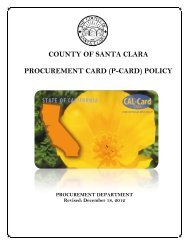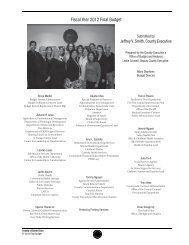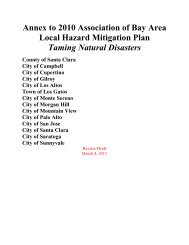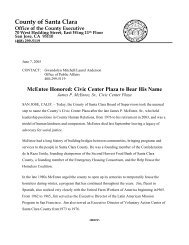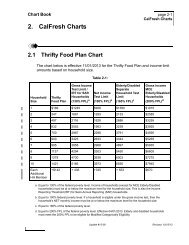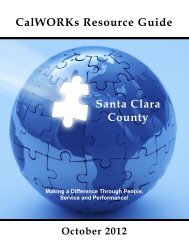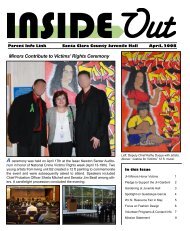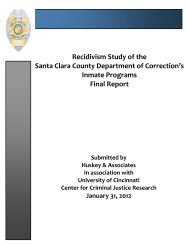Tree Brochure 2005.06.indd
Tree Brochure 2005.06.indd
Tree Brochure 2005.06.indd
Create successful ePaper yourself
Turn your PDF publications into a flip-book with our unique Google optimized e-Paper software.
Don’t<br />
plant a<br />
pest!<br />
Give them an inch and<br />
they’ll take an acre...<br />
Suggested alternatives for invasive<br />
<strong>Tree</strong>s in California<br />
B. Richardson<br />
<strong>Tree</strong>s in California<br />
California is home to the world’s tallest, largest, and oldest<br />
trees—coast redwoods, giant sequoias, and bristlecone<br />
pines. We also enjoy many beautiful landscaping<br />
trees imported from around the world.<br />
Unfortunately, a few of the<br />
trees we use in landscaping<br />
can cause serious ecological<br />
damage by escaping our<br />
gardens and spreading into<br />
California’s wildlands.<br />
These invasive trees can<br />
push out native plants, reduce<br />
wildlife habitat, impair<br />
water resources, increase<br />
erosion, create fire hazards,<br />
and degrade recreational<br />
opportunities.<br />
This brochure was developed<br />
to help gardeners<br />
and landscape designers<br />
choose trees that work for<br />
their sites while protecting<br />
the health and beauty of the<br />
California landscape.<br />
<strong>Tree</strong>-of-Heaven (Ailanthus<br />
altissima), at one time a popular<br />
street tree, has spread along the<br />
coast and through the Sierra<br />
foothills. It creates dense thickets<br />
that reduce or eliminate native<br />
vegetation and wildlife habitat.<br />
The brochure includes eighteen trees that should be<br />
avoided in gardens and landscaping in California. On the<br />
reverse side, it describes a few of the many non-invasive<br />
alternatives that can be planted in place of invasive trees.<br />
Your local nursery may also suggest alternatives best<br />
suited to your location.<br />
The invasive trees in this brochure fall into two categories.<br />
Those in the ‘Don’t Plant’ section are known to scientists<br />
to cause serious damage to wildlands in at least a<br />
portion of California and should not be planted in those<br />
areas. The trees under ‘Caution’ have been observed escaping<br />
into wildlands, but full scientific studies have not<br />
been completed on the extent of their effects.<br />
Cover: Blue gum eucalyptus (Eucalyptus globulus) invades open<br />
space in the San Francisco Bay Area.<br />
© 2002-2004 Steven J. Baskauf<br />
Don’t Plant Don’t Plant Don’t Plant Caution Caution Caution<br />
blue gum eucalyptus<br />
Eucalyptus globulus<br />
Found along the<br />
coast from Humboldt<br />
to San Diego and in<br />
the Central Valley.<br />
Most invasive in<br />
coastal locations.<br />
Easily invades native<br />
plant communities,<br />
causing declines<br />
in native plant and<br />
animal populations.<br />
Extremely flammable.<br />
Russian olive<br />
Elaeagnus angustifolia<br />
Found throughout California.<br />
Able to spread long distances<br />
with the help of birds and<br />
mammals. Invades river and<br />
stream corridors, pushing out<br />
native willows and cottonwoods.<br />
Reduces water levels.<br />
Provides poor wildlife habitat.<br />
Serious invader in other western<br />
states.<br />
black locust<br />
Robinia pseudoacacia<br />
Widely distributed, particularly<br />
in northern California and the<br />
Great Basin. Spreads by seeds<br />
and root sprouts. Forms large,<br />
dense stands. Seeds, leaves, and<br />
bark are toxic to humans and<br />
wildlife.<br />
B. Richardson<br />
© 1998 John Randall, PhD.<br />
B. Richardson<br />
saltcedar<br />
Tamarix species<br />
A serious riparian invader<br />
throughout California and<br />
southwestern states. Uses<br />
excessive amounts of water,<br />
salinates soil, changes water<br />
courses, diminishes wildlife<br />
habitat, and increases fire<br />
hazard. Not commonly sold,<br />
but still occasionally avail-<br />
Chinese tallow tree<br />
Sapium sebiferum<br />
A huge problem in southern<br />
states, this species has<br />
recently been found in California<br />
wildlands. Grows and<br />
spreads rapidly, pushing out<br />
native plants.<br />
myoporum<br />
Myoporum laetum<br />
Invades along the coast from Sonoma County to San<br />
Diego. Forms dense stands with no other vegetation. Can<br />
cover large areas.<br />
Spread by birds.<br />
Leaves and fruits<br />
are toxic to wildlife<br />
and livestock.<br />
Burns easily.<br />
Doesn’t typically<br />
spread in interior<br />
areas.<br />
© 2003 Michael Charters<br />
B. Richardson<br />
© 2002 Tony Morosco<br />
Brazilian peppertree<br />
Schinus terebinthifolius<br />
A serious problem in southern<br />
California. Less of a<br />
problem in the San Francisco<br />
Bay area and the Central<br />
Valley, but caution should<br />
be used if planting near<br />
wildlands. Creates dense<br />
stands which shade out<br />
other vegetation within a<br />
few years of introduction.<br />
scarlet wisteria<br />
Sesbania punicea<br />
New to California, spreading<br />
along the American River in<br />
central California. Also found<br />
in the Delta and in northern<br />
California. A serious problem in<br />
South Africa and Florida. Grows<br />
and spreads rapidly along river<br />
and stream corridors, pushing<br />
out native vegetation and<br />
wildlife. Seeds are moved by<br />
washing downstream.<br />
single seed hawthorn<br />
Crataegus monogyna<br />
An established invader in the Pacific Northwest, now<br />
spreading through northern<br />
California. Capable of<br />
long-range seed dispersal<br />
by birds. Creates dense<br />
thickets, changing the<br />
structure of woodland<br />
understories. May hybridize<br />
with and threaten<br />
native hawthorn species.<br />
B. Richardson<br />
© Larry Allain @ USDA-NRCS PLANTS Database<br />
© 2000 Joe DiTomaso<br />
Forest & Kim Starr, USGS<br />
The trees in the Caution section have been observed<br />
escaping into California wildlands, but<br />
it remains unclear whether they cause serious<br />
damage. You may want to avoid these if your<br />
property is located near natural areas.<br />
California peppertree<br />
Schinus molle<br />
Despite its common name, this<br />
South American plant is not native<br />
to California. Found throughout<br />
northern and central California,<br />
as well as southern parts of<br />
the state. Seeds spread by birds.<br />
Invasive in stream and riverside<br />
habitat.<br />
Canary Island<br />
date palm<br />
Phoenix canariensis<br />
Can spread quickly in<br />
southern California<br />
wetlands and riverside<br />
habitats. Seeds spread by<br />
birds.<br />
Mexican fan palm<br />
Washingtonia robusta<br />
A problem in southern California,<br />
where this palm can be<br />
prolific. Invades wildlands and<br />
crowds out natives, particularly<br />
in wetland areas.<br />
© 1999 John Randall, PhD<br />
Courtesy NZ Palm www.nzpalm.co.nz<br />
© 2000 Joe DiTomaso<br />
acacia<br />
Acacia decurrens, A. dealbata, and<br />
A. melanoxylon<br />
Acacias grow along most of<br />
the coast and inland in the<br />
central portion of the state.<br />
They spread by seed, root<br />
suckers, and stump sprouts,<br />
forming dense stands.<br />
A. dealbata<br />
mayten<br />
Maytenus boaria<br />
Has been found escaping gardens<br />
in Davis and the surrounding<br />
area. More information is<br />
being gathered about potential<br />
ecological damage this tree may<br />
cause.<br />
A. decurrens<br />
A. melanoxylon<br />
© 2000 Joe DiTomaso<br />
B. Richardson<br />
B. Richardson<br />
olive<br />
Olea europaea<br />
Produces hundreds of<br />
seeds which are spread<br />
by birds and mammals.<br />
Creates dense canopies<br />
that shade out other<br />
vegetation. Though<br />
commonly grown as<br />
a crop in California,<br />
gardeners should use<br />
caution planting this<br />
edible fig<br />
Ficus carica<br />
Can be a problem in the<br />
San Francisco Bay area,<br />
the Central Valley, and<br />
southern California. May<br />
be spread by birds and<br />
deer, as well as by vegetation<br />
fragments. Can<br />
dominate stream and<br />
riverside habitat.<br />
Melaleuca quinquenervia, the Australian<br />
paperbark tree, was introduced to Florida<br />
from Australia for landscaping purposes. Today<br />
the tree covers more than 450,000 acres<br />
of south Florida natural areas, and is one of<br />
the biggest threats to the Florida Everglades.<br />
B. Richardson<br />
B. Richardson
The California Invasive Plant Council works to<br />
protect California’s wildlands from invasive plants<br />
through education, restoration, and research. For<br />
more information please visit our website.<br />
www.cal-ipc.org<br />
The following individuals made valuable contributions<br />
to the content of this brochure:<br />
Fran Clarke<br />
Sacramento <strong>Tree</strong> Foundation<br />
Barrie D. Coate<br />
Consulting Arborist<br />
Holly Forbes<br />
U.C. Berkeley Botanical Garden<br />
Bruce W. Hagan<br />
California Dept. of Forestry and Fire Protection<br />
Warren G. Roberts<br />
U.C. Davis Arboretum<br />
Jake Sigg<br />
California Native Plant Society<br />
Non-Invasive Alternatives<br />
There are hundreds of beautiful, functional trees<br />
that do not pose an ecological threat to California’s<br />
wildlands. This brochure recommends only a selection<br />
of the trees that can be planted in place of the<br />
invasive trees on the opposite panels. Consult your<br />
local nursery or Master Gardener for additonal information<br />
on choosing the right tree for your site.<br />
Native alternatives<br />
California native trees are not found for sale as often as<br />
non-native trees. However, where conditions are appropriate,<br />
the right native tree can be a good choice—particularly<br />
those grown from locally occurring stock.<br />
Redwoods, coast live oak, and<br />
California buckeye can often be<br />
obtained at native plant sales<br />
held by chapters of the California<br />
Native Plant Society.<br />
Non-native alternatives<br />
Many non-native trees are<br />
“wildland-safe” because they<br />
cannot survive and reproduce<br />
in the wild without human<br />
care. However, much remains<br />
unknown about the ability of<br />
plants to become invasive over<br />
Symbols Used:<br />
Full sun<br />
Part shade<br />
Full shade<br />
Drought tolerant<br />
Low water<br />
Moderate water<br />
Regular water<br />
High water<br />
Zones noted from<br />
Sunset Western<br />
Garden Book<br />
time. Care has been taken to ensure that none of the<br />
recommended non-natives is invasive, but it is possible<br />
that some of these trees may become pests in the future.<br />
If you see one of the recommended alternatives growing<br />
in wildlands, please contact Cal-IPC.<br />
A note about oaks. Sudden Oak Death (SOD) is<br />
a serious disease killing oak trees and other plants in<br />
California. The three oak species recommended in this<br />
brochure are white oaks, which are less susceptible to<br />
SOD. In addition, trees planted for landscaping purposes<br />
have not, to date, been found to contract SOD. There<br />
is, however, a chance that these oaks may in the future<br />
be found to be susceptible to, or carriers of, this serious<br />
disease.<br />
Good Alternatives<br />
Arranged roughly from smallest to largest...<br />
hybrid crape myrtle<br />
Lagerstromeia hybrids<br />
Stunning tree, great in a hot<br />
area. Showy summer flowers<br />
in hot pink, white, lavender,<br />
and other colors typically give<br />
way to brilliant fall foliage.<br />
Somewhat susceptible to<br />
aphids. Not the best choice<br />
for coastal locations.<br />
Deciduous<br />
Zones: Varies by hybrid<br />
Height: 8 to 25 feet, varies<br />
by hybrid.<br />
Chinese fringe tree<br />
Chionanthus retusus<br />
Blooms like clouds of the whitest, feathery flowers.<br />
Handsome bark provides winter interest. Will grow in<br />
most central California environments.<br />
The olive-like<br />
fruits can be a litter problem.<br />
May produce a significant<br />
amount of pollen.<br />
Deciduous<br />
Zones: 3-9, 14-24<br />
Height: To 20 feet, not<br />
quite as wide.<br />
Most of these suggested trees are readily<br />
available from retail nurseries. Some can<br />
be more difficult to locate, but are worth<br />
the effort. Your local nursery may be able<br />
to special order these, or you can find them<br />
on-line and through mail order.<br />
©Erv Evans, North Carolina Cooperative Extension Service<br />
Courtesy Salisbury University Arboretum<br />
Good Alternatives Good Alternatives Good Alternatives Good Alternatives Good Alternatives<br />
bronze loquat<br />
Eriobotrya deflexa<br />
Fast growing and easily trained. New leaves emerge<br />
bright copper before turning green. Bunches of creamy<br />
white flowers in spring. Easy to plant and care for.<br />
Requires well-drained<br />
soil. Can be subject to<br />
fireblight.<br />
Evergreen<br />
Zones: 8-24<br />
Height: 12-30 feet<br />
Width: 15-30 feet<br />
sweet michelia<br />
Michelia doltsopa<br />
Prune to create a narrow, upright tree. Furry brown buds<br />
open to cream or white<br />
blossoms. Thin, leathery,<br />
dark green leaves are red<br />
underneath.<br />
Evergreen<br />
Zones: 15-24<br />
Height: To 25 feet<br />
eastern redbud<br />
Cercis canadensis<br />
Can be fast-growing. Rosy pink flowers bloom before<br />
new leaves appear and are followed by beanlike pods.<br />
Prefers well-drained soil. Cercis reniformis ‘Oklahoma’<br />
is also popular.<br />
Deciduous<br />
Zones: 1-24<br />
Height: 25-35 feet<br />
Width: 25-35 feet<br />
www.worldplants.com<br />
Luen Miller, Monterey Bay Nursery, Inc.<br />
Paul Redfearn, Ozarks Regional Herbarium,<br />
Southwest Missouri State University<br />
Japanese snowdrop tree<br />
Styrax japonicus<br />
Slender, graceful trunk. Broad crown. Leaves may turn red<br />
or yellow in fall. Delicate, fragrant, white flowers hang<br />
below leaves, creating a<br />
layered effect.<br />
Deciduous<br />
Zones: 4-9, 14-21<br />
Height: 30 feet, narrow in<br />
youth, wide in maturity<br />
marina strawberry tree<br />
Arbutus ‘Marina’<br />
Rosy pink, urn-shaped flowers,<br />
deep red bark, and strawberrylike<br />
fruits in yellow and red. Easy<br />
to plant and care for. Can be<br />
susceptible to greenhouse thrips.<br />
Doesn’t tolerate very alkaline or<br />
poorly drained soil. Can be slow<br />
to reach tree size.<br />
Evergreen<br />
Zones: 8, 9, 14-24<br />
Height & Width: To 40 feet<br />
water gum<br />
Tristaniopsis laurina<br />
Formal plant, can be<br />
trained as a single or<br />
multistemmed tree. Mahogany-colored<br />
bark peels,<br />
revealing new, satiny white<br />
bark beneath. Yellow flowers<br />
produce a good show. Can be<br />
slow-growing. Damaged by very<br />
cold winters. Try cultivar ‘Elegant.’<br />
Evergreen<br />
Zones: 15-24<br />
Height: To 45 feet<br />
Width: 5-30 feet<br />
JC Raulston Arboretum, North<br />
Carolina State University<br />
© Monrovia<br />
© Murray Fagg, Australian National<br />
Botanic Gardens<br />
Nichol’s willow-leafed peppermint<br />
Eucalyptus nicholii<br />
One of the cleanest, most graceful eucalyptus, with<br />
weeping branches and not too much litter. Crushed<br />
leaves smell a bit like peppermint.<br />
Furrowed, rich, reddish-brown<br />
bark. Damaged by very cold win-<br />
ters.<br />
Evergreen<br />
Zones: 5, 6, 8-24<br />
Height: 36-48 feet<br />
Width: 15-36 feet<br />
tupelo<br />
Nyssa sylvatica<br />
Crooked branches and dark, red-tinged bark make a<br />
dramatic winter picture. Birds<br />
are attracted to the fruit. Leaves<br />
turn yellow, orange, and red<br />
before dropping in fall. Excellent<br />
shade tree. Poor in air pollution.<br />
Needs acidic soil with no<br />
salinity.<br />
Deciduous<br />
Zones: 2-10, 14-21<br />
Height: 30-50 feet<br />
Width: 15-25 feet<br />
Japanese blueberry tree<br />
Elaeocarpus decipiens<br />
New leaves rusty and hairy, turning smooth and bright<br />
green. Old leaves turn red before dropping. Blooms with<br />
tiny, scented white flowers in clusters followed by small,<br />
blue-black, edible fruits. Likes<br />
rich, well-drained soil. Needs<br />
little pruning.<br />
Evergreen<br />
Zones: 8-9, 14-24<br />
Height: 30-60 feet<br />
Width: 20-30 feet<br />
Ian Barclay<br />
© 2000 W.J. Hayden<br />
davesgarden.com<br />
southern live oak<br />
Quercus virginiana<br />
Relatively fast-growing and<br />
long-lived. Very attractive<br />
in hot, interior climates.<br />
Easy to plant and care for.<br />
Evergreen<br />
Zones: 4-24<br />
Height: 40-80 feet<br />
Width: 80-160 feet<br />
bald cypress<br />
Taxodium distichum<br />
Delicate, feathery foliage sprays turn reddish-brown<br />
before dropping in the fall. Tolerates drought or very wet<br />
conditions, and any but the most alkaline soil. Trunk can<br />
be buttressed at the base. No<br />
pests or diseases. Easy to plant<br />
and care for. Tolerates any<br />
amount of water.<br />
Deciduous<br />
Zones: 2-10, 12-24<br />
Height: 50-70 feet,<br />
Width: 20-30 feet<br />
burr oak<br />
Quercus macrocarpa<br />
Rugged-looking tree with flaky<br />
grayish bark. Long, deeply lobed<br />
leaves are glossy green. Large, distinctive<br />
acorns covered in fringed<br />
cap. Tolerant of poor conditions.<br />
Acorns can be a trip hazard.<br />
Deciduous<br />
Zones: 1-11, 14-23<br />
Height: 60-75 feet, equally<br />
wide when mature<br />
© J.R. Manhart<br />
Courtesy Plant Resources Center,<br />
University of Texas at Austin<br />
© 2002-04 Steven J. Baskauf<br />
tulip tree<br />
Liriodendron tulipifera<br />
Straight, columnar trunk with a tall, pyramidal crown.<br />
Unique lyre-shaped leaves. Foliage starts bright green,<br />
turns bright yellow in fall. Tulip-shaped flowers in late<br />
spring are interesting but not showy. Beautiful large<br />
shade or lawn tree.<br />
Likes slightly acidic,<br />
well-drained soil and<br />
plenty of room.<br />
Deciduous<br />
Lemke E.<br />
Zones: 2-12, 14-24<br />
David<br />
Height: 60-80 feet<br />
2001 ©<br />
Width: To 40 feet<br />
dawn redwood<br />
Metasequoia glyptostroboides<br />
Soft pale green needles turn reddish-brown before falling<br />
in autumn, leaving a beautiful<br />
winter silhouette. Grows very fast<br />
when young. Older trees have fluted<br />
trunks. Resistant to oak root fungus.<br />
Not suitable for very arid regions or<br />
the coast.<br />
Deciduous<br />
Pacula<br />
Zones: 3-10, 14-24<br />
Bartosz<br />
Height: To 90 feet<br />
Width: To 20 feet Courtesy<br />
The trees suggested in this brochure represent<br />
only a small number of the beautiful,<br />
non-invasive trees available in California<br />
for home and professional landscaping.<br />
Ask your local nursery professional, or one<br />
of the many non-profit organizations dedicated<br />
to urban trees, for additional suggestions<br />
and advice.




